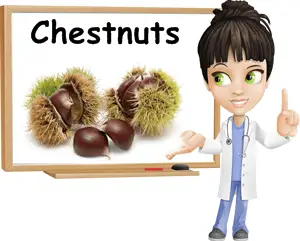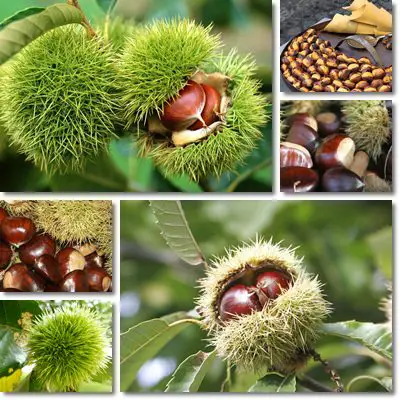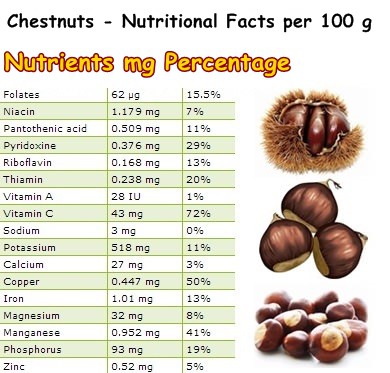A delicious treat from autumn’s goodies basket, chestnuts are a sweet and nutritious food, highly appreciated for their unique taste. Chestnut trees are native to the Northern Hemisphere and thrive in countries such as Japan, China and throughout Europe and North America. China is the biggest producer of chestnuts.
Although chestnut trees can be found in everywhere from roadsides and parks to back yards, their fruit is not necessarily edible. Some varieties are poisonous, which is why you should not rush and eat some chestnuts you’ve found beneath a tree in the park.
Read more and find out how to recognize edible varieties from inedible ones and how you can benefit from the wonderful properties and health benefits of chestnuts.
Chestnut trees have either female or male flowers, meaning that you’d need a boy tree and a girl tree for the pollination process to occur and get fruits. When pollination occurs, chestnut flowers with a sweet, yet heavy smell appear. The pollen from these flowers may be upsetting for those suffering from seasonal allergies as it is quite allergenic. Honey can be made from chestnut flowers, but anyone allergic to chestnut pollen or bee products should avoid the honey in any form or preparation.
See the benefits of chestnut honey.

What to chestnuts look and taste like?
The fruits of the chestnut tree, called sweet chestnuts, are enclosed in a light green husk with thin spikes, almost like very prickly long hairs or needles. The husk usually breaks open when the chestnuts inside are ripe and fall on the ground. Each husk reveals one relatively small, rounded, brown nut that further contains two edible brown seeds, flattened on one side. Some varieties only have one seed. The peel of these seeds needs to be removed to access the creamy white, edible flesh of the chestnut. Chestnuts taste nutty, with faint sweet flavors and a creamy texture.
Edible vs inedible chestnuts
There is also an inedible chestnut variety called the horse chestnut and it can be distinguished from edible varieties by its large thorn-like protuberances on the husk that give it a more menacing appearance. Usually the thorns on inedible chestnuts are fewer in number, while the needle-like hairs on the husks of edible chestnut varieties are much more abundant. The edible varieties also have a cream-colored spot on the peel of the seeds and each seed has a sort of a tassel. Inedible chestnuts are rounder or slightly irregular in shape and brown all over, without a discolored spot.
Edible chestnut varieties
There are several edible chestnut varieties, including the following:
- The Japanese chestnut (Castanea crenata), a sweet October variety of significantly large sizes.
- The Chinese chestnut (Castanea mollissima).
- The sweet chestnut (Castanea sativa) is native to the European continent. It is also known as the Spanish or Portuguese chesnut.
- The American chinquapin (Castanea pumila), or the dwarf chestnut.
- The American chestnut (Castanea dentata).

What are the health benefits?
First of all, chestnuts are moderately low in calories, containing approximately 200 kcal/100 g of nuts. Unlike walnuts, almonds and macadamia nuts, which have an incredibly high caloric value, this nut variety can be consumed without fear of gaining weight. In addition to this, it has a high starch intake, similar to potatoes and corn.
Chestnut flour (made from dried, milled chestnuts) can be used to make bread, polenta, doughnuts, pancakes or cakes or it can be added to soups or sauces to thicken them. Its nutty flavor will make your dishes uniquely savory.
Chestnuts are also a rich and varied source of vitamins and minerals, the most notable being folate, pyridoxine, riboflavin, thiamine, vitamin C, potassium, copper, iron, manganese and phosphorus. The high vitamin C content of chestnuts is by far the most interesting and somewhat intriguing aspect. Nuts rarely have vitamin C, let alone such high levels (72% of the recommended daily intake of vitamin C).
This powerful antioxidant vitamin is essential for the formation of collagen, a protein which keeps us looking young and beautiful. Also, it stimulates immunity by strengthening our immune system’s response to infections and protects against free radical damage. But remember that cooking heat destroys vitamin C so baking or boiling chestnuts can result in them losing their vitamin C content.

Aside from this, chestnuts also boast generous amounts of B vitamins. Folate or vitamin B9 is found in most nuts and seeds and is necessary for DNA synthesis and red blood cell production. Consuming folate-rich foods before conception and during pregnancy will successfully prevent neural tube defects such as gaps in the spinal cord, paralysis and even death of newborns.
Chestnuts also contain significant amounts of pyridoxine or vitamin B6, which helps lower the risks of coronary heart disease. Thiamine, or vitamin B1, prevents tingling sensations and numbness in lower and upper limbs. Including chestnuts in your diet may be more beneficial than you could imagine.
Because of their high copper content (50%), chestnuts may help prevent premature hair graying. Iron is good for anyone suffering from anemia, while potassium regulates heart pressure and body fluids. Last but not least, manganese has powerful antioxidant properties.
Are chestnuts gluten free?
Are chestnuts gluten free? Chestnuts and the by-products made from them, notably chestnut flour, are gluten-free and can be safely consumed by anyone suffering from celiac disease or gluten intolerance. A gluten-free diet may seem to lack variety, but a bit of imagination and patience can make up for the trademark rigor and strictness. For instance, chestnut flour can be used to make breads, biscuits and even pancakes or crepes. If anything, it’s a start.
Conclusion
Chestnuts are both healthy and delicious to eat. Their sweet, nutty flavor can easily compliment a balanced, varied diet and provide important nutrients our body requires to stay in good health. However, remember that an untrained eye may easily be fooled by a seemingly harmless, yet dangerous food such as the chestnut. The same goes for mushrooms and almonds. If you are experienced at telling apart the edible varieties from the inedible ones, then good for you. If not, then avoid picking chestnuts, especially off the ground or from parks or forests and only eat those you purchase at the supermarket where there are only edible varieties available.
